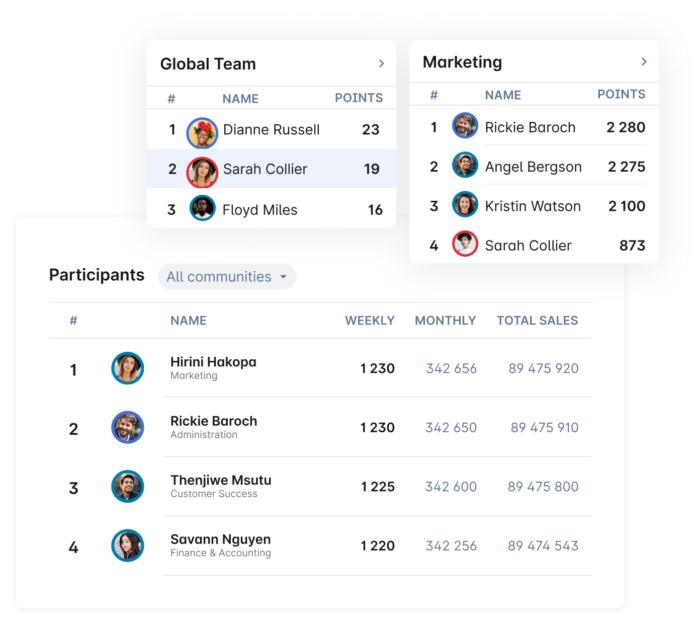Beyond Retail Product Training: How Relevant, Engaging, and Timely Brand Content Drives Sell-Through
5 Frontline Pain Points for 2023 and How to Solve Them
It’s no secret that the frontline workforce has changed, with frontline training and customer experience (CX) being more important than ever. We saw this at NRF, and we’ll continue seeing this trend grow. Customers and associates today have higher expectations for retailers, in part because of inflation, but also because their choices are just so much more plentiful. Retailers will have to innovate on a technological level in order to meet these challenges.
Evolutions in CX, But What About Frontline Training and Performance?
Yet while most retailers have innovated in CX, with virtual merchandising and product personalization, many have yet to consider how to upgrade the frontline experience. Though many frontline workers have digital tools, these tools aren’t up to the job: they’re hard to use, spread out in separate locations, and fail to alert the user at the right moment of what to do. Software tools, many retailers have said, have a low adoption rate among consumers and their workforce, which squanders opportunities for transformation as well as wasting money.
With that in mind, here are 5 frontline pain points commonly encountered in retail today, and how the right technology helps retailers solve them – but only the right technology, configured in the most efficient and dynamic ways. Note that these pain points are not only solved for the frontline, but also for the administrators who supervise frontline training and coordinate their operations.
1. Consolidation of Software Tools
One problem that’s arisen recently in retail is consolidation of tech tools. Imagine a retail worker, Sarah, who sells high-ticket furniture at a chain retailer. Sarah is hard working and wants to (a) know as much as possible about the products she’s selling, and (b) be able to track her sales cycles with specific customers.
Yet because her frontline training, learning, and onboarding tools are in different locations on his mobile device than her sales tools, her performance data and learning data aren’t informing each other. That sinks her performance.
A better framework for performance is possible, one grounded in the consolidation of tools. Imagine that Sarah uses an all-in-one suite, accessed from a single entry point on his mobile device while she’s on the floor. Rallyware is exactly that, one sign-on where every tool is integrated. Yet that doesn’t only mean she’s faster and more efficient. Because data moves freely from one tool into another, his experience of the platform is personalized for her in order to drive his sales performance upward, continuously. His learning informs his sales activity, and vice versa, so that the platform knows what nudge she needs when he needs it; each interaction with the platform enriches her experience of it.
It’s not just consolidation for the sake of having every tool in one place. It’s about raising business value worker by worker, team by team, from frontline training to productivity tools.

2. Driving Real Behaviors
While retailers have started using tools for performance management, are these tools really effective in driving the right behaviors? Too often, retailers find that their software platforms are emphasizing compliance with organization protocol more than changing real behaviors. The goal is to make the frontline more productive and proactive.
If you’re a retailer, ideally, you want to find technology that organically drives those outcomes, rather than saying, “Do this now.” Compliance is often going to run dry and lead to burnout – not the result you want!
Performance enablement technology like Rallyware uses a smart business rules and recommendations engine to drive and reinforce the most productive behaviors for the frontline workforce. The right activity gets shown to the right frontline worker at the right time, leading to the right behaviors – those behaviors desired by the company, and which are beneficial to the frontline worker.
Real-World Frontline Training, Learning, and Performance Activity Results
When this approach, like with Rallyware, combines learning and business activities, leads to results such as:
- Learning activities alone increased productivity by 8%.
- Learning activities and business activities increased productivity by 14%.
- Learning activities and business activities delivered via smart notifications increased productivity by 34%.
Check out Rallyware’s performance enablement whitepaper to learn more about how technology can be used not only to optimize processes, but productivity and results. Retail analytics software and performance enablement technology can have these kind of results, but as we will see, it has to be easy to use, even if the technology in the background is complicated and data-rich.
3. Simplification of the Day
Throughout his workday, Sarah has a ton going on – and even more now that her company has inventory overstocks, like many retailers these days. On the other hand, her company has runs on certain products – which result in stockouts. She has to focus on selling apparel, on performing daily tasks, on providing customer service, on managing stockouts and more.
Her technology should centralize and simplify her day, digitalizing it in a single app. Whether she’s involved in frontline training or customer retention, everything should be unified. Each type of activity and task should inform and contextualize the other types of activities and tasks, forming one easy-to-follow workflow; though complex in the background, the experience is simple and easy to use. The app should also integrate with all external technologies, like scheduling software, to know when she’s ready to start receiving messages, and what point she’s at during her day, when.
The app should also be easy for HQ to administer. Retail analytics software should not be complex but rather create efficiencies for corporate leaders, so they can spend more time evaluating results and planning the future, rather than just determining insights.
Sarah’s app should always notify her of his next steps to take, the steps that will be most engaging and productivity-stimulating to her. This way, if her app is smarter and more responsive to the reality happening in front of her on the sales floor, she’s more likely to actually adopt and use it.
4. Rewarding and Recognizing High Performers
One problem for many retailers is that their rewards and recognition programs can’t keep pace with the speed of the day. They might recognize employees of the month, or give promotions to frontline workers over time – but what about day-to-day and week-to-week performance?
For instance, if Sarah has been selling continuously well over a period of days, and she’s the second-best associate in the store, she should receive some sort of recognition to keep him engaged and sales-ready. Even if she’s just finished frontline training, she should get some kind of acknowledgement.
Rallyware’s app has a solution. Rallyware’s Incentives & Recognitions solution rewards and recognizes high performance to automatically gamify the workforce experience (WX). With leaderboards, dashboards, company-specific awards for business achievements, custom widgets to visualize sales progress, and much more, Rallyware makes sure that employees like Sarah are automatically engaged and re-engaged in their WX.

5. Modernizing the Retail Workforce Experience (WX)
Lastly, it’s important to recognize that the WX for the frontline has changed. The gig economy is huge, and growing, with its market share expected to read $455 billion USD in 2023. Many gig platforms like Uber and TaskRabbit have modern, sleek, all-in-one apps that make it easy to be productive when and however much gig workers want. That’s the kind of experience that retailers, and other deskless industries, are competing against for employees.
What Should All-in-One Performance Enablement and Retail Analytics Software Have?
At a time of a continued labor shortage, it’s important to have technology that can compete with gig work platforms. Technology with these highlights:
- Consolidated: That is consolidated/all-in-one
- Behavior Driver: That drives productive behaviors in a way that “knows” the worker’s preferences and goals
- Easy to Use: That is simple for the end user but complexly engineered
- Recognizes / Motivates Performance: That rewards high performance for continued increases in productivity – a positive feedback loop
Such modern, plug-and-play technology, platforms which can compete with high-tech gig platforms, does exist for retail. Rallyware is a fantastic example of performance enablement for the retail frontline that increases business outcomes at scale while making corporate admins’ lives easier.
To motivate and engage your workforce, you’ll need the right technology – a platform using context and data to trigger the right activities at the right times for the right behaviors. Click here to see Rallyware in action or read more about our performance enablement suite.
News and Insights on Workforce Training & Engagement
We’re among top-notch eLearning and business engagement platforms recognized for effective training and talent development, helping to empower distributed workforces
Subscribe
